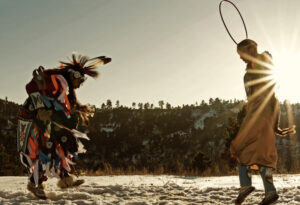Film Review: “Women of the White Buffalo” Balances Grief and Hope
Written by: Heidi Shepler | April 11th, 2022

Women of the White Buffalo (Deborah Anderson, 2022) 3½ out of 4 stars.
In Women of the White Buffalo, Carol Iron Rope-Herrera uses the term cultural competence to describe “a set of congruent behaviors … amongst professionals that enables them to work effectively in cross-cultural situations.” This cultural competence is especially vital to avoid perpetuating stereotypes in depictions of Native American communities. Director Deborah Anderson (Aroused) demonstrates this competence through a nuanced, unflinching look at how the struggles Lakota women and their families face today are connected to colonialism and cultural genocide, and how multiple generations of Lakota activists, educators, and artists are working to heal their people.
One of the strengths of Women of the White Buffalo is that the film gives equal weight to the past and present. The history of boarding schools, where children were forced to renounce their culture for generations, is juxtaposed with modern teachers’ being forced to teach to state standards at the cost of giving less attention to Lakota values and history. The nineteenth-century deliberate hunting of buffalo to near-extinction is juxtaposed with modern subsidized grocery stores, where a bell pepper is four dollars but candy bars are one dollar. The tools and excuses of dominant culture change, but the results of systemic cultural abuse stay the same.

©Deborah Anderson Creative
While several of the women interviewed have suffered harrowing loss and abuse, they are all shown respect and portrayed as whole people. It would be only too easy to sensationalize their experiences, but the film never does. Julie Richards, founder of Mothers Against Meth Alliance, or M.A.M.A., speaks openly about the effect meth has had on the community. She indicates damage done to her home and car and says, “I started publicly shaming the meth dealers, so that’s why my house looks like this.” But she says it with a smile, and with hard-earned pride at the good her activism has achieved.
Likewise, Vandee Khalsa-Swiftbird speaks frankly about how easily children can become victims of sex trafficking. She recounts her own experiences and reminds the audience that trafficking is not getting better; in fact, it’s getting worse. But towards the end of the film she also discusses how reclaiming her heritage has led her toward healing: she is now an activist and has adopted a daughter whose mother struggled with the same addictions as her own mother. Khalsa-Swiftbird speaks joyfully and tearfully about the privilege of raising her little girl and doing what she can to break the cycle of violence.

©Deborah Anderson Creative
The message of Women of the White Buffalo is neither cynical nor comforting. The women interviewed in the film are fighting against centuries of poverty, violence, and mainstream indifference. But they are fighting. “America did a really good job of trying to wipe us out, but they didn’t finish the job,” says SunRose IronShell. The film originally ended on an uplifting note, with a quote from Crazy Horse predicting that the Lakota would play an instrumental role in the eventual healing of the world. However, the current ending reminds us that COVID-19 has affected Native communities, including the Lakota, at disproportionately high rates. In addition, the film is dedicated to the memory of Carol Iron Rope-Herrera, who throughout the film was portrayed as a vital source of knowledge and comfort to her people.

